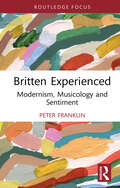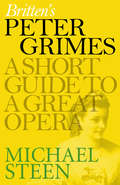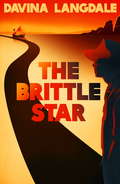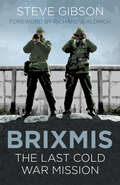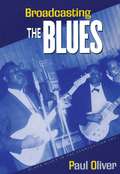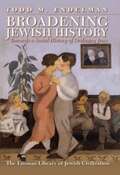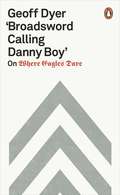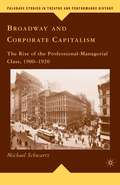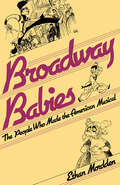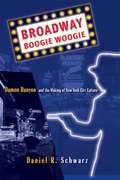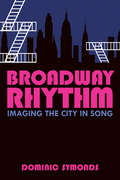- Table View
- List View
Britten Experienced: Modernism, Musicology and Sentiment
by Peter FranklinWho writes the books we read about music that excites us, and why? Is ‘classical music’ all about class? Related questions underpin this partly polemical study, written by an academic who believes that the Humanities, to be really humane, must confront their methods and aims. Two recent studies of Benjamin Britten have specifically interested the author, who was educated in a world where the composer was a living subject of criticism and praise, his works reflecting values, worries and dramas that were not just about ‘music’. Franklin’s response is to question the recent writers, proposing that, like theirs, his own story conditioned when and how he experienced Britten. This he unfolds autobiographically in and around the discussion of specific works. Recalling his encounters with the composer as a schoolboy, as a student and opera-goer, and then as a teacher, he challenges recent assertions about Britten and modernism in the period.
Britten Experienced: Modernism, Musicology and Sentiment
by Peter FranklinWho writes the books we read about music that excites us, and why? Is ‘classical music’ all about class? Related questions underpin this partly polemical study, written by an academic who believes that the Humanities, to be really humane, must confront their methods and aims. Two recent studies of Benjamin Britten have specifically interested the author, who was educated in a world where the composer was a living subject of criticism and praise, his works reflecting values, worries and dramas that were not just about ‘music’. Franklin’s response is to question the recent writers, proposing that, like theirs, his own story conditioned when and how he experienced Britten. This he unfolds autobiographically in and around the discussion of specific works. Recalling his encounters with the composer as a schoolboy, as a student and opera-goer, and then as a teacher, he challenges recent assertions about Britten and modernism in the period.
Britten's Peter Grimes: A Short Guide to a Great Opera (Great Operas)
by Michael SteenBritten’s opera Peter Grimes is based on George Crabbe’s horrifying poem The Borough about early 19th century Aldeburgh, a North Sea fishing town in East Anglia. Its premiere at Sadlers Wells in 1945, shortly after VE Day, was a landmark moment in British operatic history. Britten’s partner Peter Pears – like Britten a pacifist and conscientious objector – was in the title role. Britten and Pears, together with Montagu Slater, a communist journalist, created the libretto.Grimes, a fisherman and sadistic child abuser, is a loner longing for social acceptance, and the wealth to marry the retired schoolmistress Ellen Orford. Britten, a homosexual whose circle included E.M. Forster and Christopher Isherwood, wanted to win sympathy for outsiders. Yet after Grimes has destroyed yet another apprentice, and himself committed suicide, life just goes on as usual in the bustling, hypocritical town. ‘The Borough’ has a pompous mayor, a typical pub landlady, a drunken Methodist, an ineffectual parson, a drug-addicted rich widow. A pub brawl and barn dance conceal the dark side of this community: its hysteria, its busybodies, its lynch-mob justice. The opera and its story, as depicted in Britten’s evocative music, haunts the audience long after the curtain comes down. Written by Michael Steen, author of the acclaimed The Lives and Times of the Great Composers, ‘Short Guides to Great Operas’ are concise, entertaining and easy to read. They are packed with useful information and informed opinion, helping to make you a truly knowledgeable opera-goer, and so maximising your enjoyment of a great musical experience.Other ‘Short Guides to Great Operas’ that you may enjoy include La Bohème, Don Giovanni and Eugene Onegin.
The Brittle Star: An epic story of the American West
by Davina LangdaleA DAILY MAIL STARS BOOK OF THE YEARA FOYLES BEST BOOK OF 2017'Langdale is excellent . . . The Brittle Star is a great beginning to what I hope is a long and productive career' GuardianIf a man beats you, you never let your anger show, never at the time. You wait, until he least expects it, until nobody remembers that you were angry at all . . . In 1860s Southern California, life on the Burn ranch has been peaceful for 15-year-old John Evert since the death of his father. But recently there have been violent raids on nearby properties, where it's not just cattle and horses that are taken, but women too. And when the white-painted men arrive at the Burn ranch on horses in the dead of night, John Evert is near-fatally injured, his beloved mother spirited away, and their house torched to the ground. Setting out on a journey to find his mother and reclaim his land, John Evert will fight in the Civil War and befriend an outlaw, challenge his assumptions and fall in love, before returning to fledgling Los Angeles older, sager and set on revenge . . .'Fans of Annie Proulx, or Cormac McCarthy's Border Trilogy will love her eloquent descriptions of California's rural terrain' Henry Deedes, Daily Mail'This book artfully blends careful research with beautiful writing. This young British writer is clearly incredibly talented and versatile, and I hope this will be the first book in a long and fruitful career' Historical Novel Society
Brittle with Relics: A History of Wales, 1962–97 ('Oral history at its revelatory best' DAVID KYNASTON)
by Mr Richard KingBrittle with Relics is a landmark history of the people of Wales during a period of great national change.'Richly humane, viscerally political, generously multi-voiced, Brittle with Relics is oral history at its revelatory best: containing multitudes and powerfully evoking that most remote but also resonant of times, the day before yesterday.'DAVID KYNASTONThere is no present in Wales,And no future;There is only the past,Brittle with relics.- 'A Welsh Landscape', R. S. ThomasIn the closing third of the twentieth century, Wales experienced the simultaneous effects of deindustrialisation, the subsequent loss of employment and community cohesion, and the struggle for its language and identity. These changes were largely forced upon the country, whose own voice, rarely agreed upon within its borders, had to fight to be heard outside of Wales.Brittle with Relics is a history of the people of Wales undergoing some of the country's most seismic and traumatic events: the disasters of Aberfan and Tryweryn; the rise of the Welsh language movement; the Miners' Strike and its aftermath; and the narrow vote in favour of partial devolution.Featuring the voices of Neil Kinnock, Rowan Williams, Leanne Wood, Gruff Rhys, Michael Sheen, Nicky Wire, Sian James, Welsh language activists, members of former mining communities and many more, this is a vital history of a nation determined to survive, while maintaining the hope that Wales will one day thrive on its own terms.'A testament to the brutal circumstances that bonded the communities of Wales into a new polity for the 21st century.'GRUFF RHYS'This book is a guide to remembering who we can be when we work together.'GWENNO SAUNDERS'An essential telling of Welshness that contains a powerful reflection of Englishness, too.'EMMA WARREN
BRIXMIS: The Last Cold War Mission
by Steve GibsonBRIXMIS (British Commander-in-Chief’s Mission to the Group Soviet Forces of Occupation in Germany) is one of the most covert elite units of the British Army. They were dropped in behind ‘enemy lines’ ten months after the Second World War had ended and continued with their intelligence-gathering missions until the fall of the Berlin Wall in November 1989. During this period Berlin was a hotbed of spying between East and West. BRIXMIS was established as a trusted channel of communication between the Red Army and the British Army on the Rhine. However, they acted in the shadows to steal advanced Soviet equipment and penetrate top-secret training areas. Here Steve Gibson offers a new understanding of the complex British role in the Cold War.
Broad and Narrow Interpretations of Philosophy of Technology: Broad and Narrow Interpretations (Philosophy and Technology #7)
by Paul T. DurbinBACKGROUND: DEPARTMENTS, SPECIALIZATION, AND PROFESSIONALIZATION IN AMERICAN HIGHER EDUCATION For over half of its history, U.S. higher education turned out mostly cler gymen and lawyers. Looking back on that period, we might be tempted to think that this meant specialized training for the ministry or the practice of law. That, however, was not the case. What a college education in the U.S. prepared young men (almost exclusively) for, from the founding of Harvard College in 1636 through the founding of hundreds of denominational colleges in the first two-thirds of the nineteenth century, was leadership in the community. Professionalization and specialization only began to take root, and then became the dominant mode in U.S. higher education, in the period roughly from 1860--1920. In subsequent decades, that seemed to many critics to signal the end of what might be called "education in wisdom," the preparation of leaders for a broad range of responsibilities. Professionalization, specialization, and departmentalization of higher education in the U.S. began in the last quarter of the nineteenth century.
Broad Gauge Railways (Shire Library #850)
by Tim BryanIsambard Kingdom Brunel considered the Great Western Railway the 'finest work in England' and he contributed many groundbreaking features, none so unorthodox as the decision not to adopt the 'standard' track gauge of 4ft 8½in and instead introduce the new 'broad gauge' of 7ft ¼in. Describing the rationale behind the choice of broad gauge, and also the unique track and locomotives used, this beautifully illustrated introduction to broad gauge railways chronicles the building of the original GWR between Bristol and London, and the expansion of that original 112-mile main line into a network stretching across the West of England, Wales and the Midlands. It describes how the clash between broad and narrow led to the 'Battle of the Gauges' and also provides a list of places to visit where broad gauge artefacts still survive.
Broad Gauge Railways (Shire Library #850)
by Tim BryanIsambard Kingdom Brunel considered the Great Western Railway the 'finest work in England' and he contributed many groundbreaking features, none so unorthodox as the decision not to adopt the 'standard' track gauge of 4ft 8½in and instead introduce the new 'broad gauge' of 7ft ¼in. Describing the rationale behind the choice of broad gauge, and also the unique track and locomotives used, this beautifully illustrated introduction to broad gauge railways chronicles the building of the original GWR between Bristol and London, and the expansion of that original 112-mile main line into a network stretching across the West of England, Wales and the Midlands. It describes how the clash between broad and narrow led to the 'Battle of the Gauges' and also provides a list of places to visit where broad gauge artefacts still survive.
Broad Is My Native Land: Repertoires and Regimes of Migration in Russia's Twentieth Century
by Lewis H. Siegelbaum Leslie Page MochWhether voluntary or coerced, hopeful or desperate, people moved in unprecedented numbers across Russia’s vast territory during the twentieth century. Broad Is My Native Land is the first history of late imperial, Soviet, and post-Soviet Russia through the lens of migration. Lewis H. Siegelbaum and Leslie Page Moch tell the stories of Russians on the move, capturing the rich variety of their experiences by distinguishing among categories of migrants—settlers, seasonal workers, migrants to the city, career and military migrants, evacuees and refugees, deportees, and itinerants. So vast and diverse was Russian political space that in their journeys, migrants often crossed multiple cultural, linguistic, and administrative borders. By comparing the institutions and experiences of migration across the century and placing Russia in an international context, Siegelbaum and Moch have made a magisterial contribution to both the history of Russia and the study of global migration. The authors draw on three kinds of sources: letters to authorities (typically appeals for assistance); the myriad forms employed in communication about the provision of transportation, food, accommodation, and employment for migrants; and interviews with and memoirs by people who moved or were moved, often under the most harrowing of circumstances. Taken together, these sources reveal the complex relationship between the regimes of state control that sought to regulate internal movement and the tactical repertoires employed by the migrants themselves in their often successful attempts to manipulate, resist, and survive these official directives.
Broadcasting Fidelity: German Radio and the Rise of Early Electronic Music
by Myles W. JacksonA landmark history of early radio in Germany and the quest for broadcast fidelityWhen we turn on a radio or stream a playlist, we can usually recognize the instrument we hear, whether it&’s a cello, a guitar, or an operatic voice. Such fidelity was not always true of radio. Broadcasting Fidelity shows how the problem of broadcast fidelity pushed German scientists beyond the traditional bounds of their disciplines and led to the creation of one of the most important electronic instruments of the twentieth century.In the early days of radio, acoustical distortions made it hard for even the most discerning musical ears to differentiate instruments and voices. The physicists and engineers of interwar Germany, with the assistance of leading composers and musicians, tackled this daunting technical challenge. Research led to the invention in 1930 of the trautonium, an early electronic instrument capable of imitating the timbres of numerous acoustical instruments and generating novel sounds for many musical genres. Myles Jackson charts the broader political and artistic trajectories of this instrument, tracing how it was embraced by the Nazis and subsequently used to subvert Nazi aesthetics after the war and describing how Alfred Hitchcock commissioned a later version of the trautonium to provide the sounds of birds squawking and flapping their wings in his 1963 thriller The Birds.A splendid work of scholarship by an acclaimed historian of science, Broadcasting Fidelity reveals how the interplay of science, technology, politics, and culture gave rise to new aesthetic concepts, innovative musical genres, and the modern discipline of electroacoustics.
Broadcasting Fidelity: German Radio and the Rise of Early Electronic Music
by Myles W. JacksonA landmark history of early radio in Germany and the quest for broadcast fidelityWhen we turn on a radio or stream a playlist, we can usually recognize the instrument we hear, whether it&’s a cello, a guitar, or an operatic voice. Such fidelity was not always true of radio. Broadcasting Fidelity shows how the problem of broadcast fidelity pushed German scientists beyond the traditional bounds of their disciplines and led to the creation of one of the most important electronic instruments of the twentieth century.In the early days of radio, acoustical distortions made it hard for even the most discerning musical ears to differentiate instruments and voices. The physicists and engineers of interwar Germany, with the assistance of leading composers and musicians, tackled this daunting technical challenge. Research led to the invention in 1930 of the trautonium, an early electronic instrument capable of imitating the timbres of numerous acoustical instruments and generating novel sounds for many musical genres. Myles Jackson charts the broader political and artistic trajectories of this instrument, tracing how it was embraced by the Nazis and subsequently used to subvert Nazi aesthetics after the war and describing how Alfred Hitchcock commissioned a later version of the trautonium to provide the sounds of birds squawking and flapping their wings in his 1963 thriller The Birds.A splendid work of scholarship by an acclaimed historian of science, Broadcasting Fidelity reveals how the interplay of science, technology, politics, and culture gave rise to new aesthetic concepts, innovative musical genres, and the modern discipline of electroacoustics.
Broadcasting the Blues: Black Blues in the Segregation Era
by Paul OliverBroadcasting the Blues: Black Blues in the Segregation Era is based on Paul Oliver's award-winning radio broadcasts from the BBC that were created over several decades. It traces the social history of the blues in America, from its birth in the rural South through the heyday of sound recordings. Noted blues scholar Paul Oliver draws on decades of research and personal interviews with performers--some of whom he "discovered" and recorded for the first time--to draw a picture of how the blues aesthetic developed, giving new insights into the role blues played in American society before racial integration. The book begins by outlining the history of the blues from African music through country stomps, ragtime songs, and field hollers. From the heroic figures of black folksong--including the steel-driving railroad worker John Henry and the destructive Boll Weevil--to the content of the emerging blues, the author discusses the "meaning" behind the often coded words of the blues, evoking topics such as playful sexuality, magic and medicine, the stresses of segregation, and commentary on national events. Finally, the author traces the history of blues documentation, showing how our views of the early blues have been shaped through a complex interplay of social forces, and indicating possible lines for future research.
Broadcasting the Blues: Black Blues in the Segregation Era
by Paul OliverBroadcasting the Blues: Black Blues in the Segregation Era is based on Paul Oliver's award-winning radio broadcasts from the BBC that were created over several decades. It traces the social history of the blues in America, from its birth in the rural South through the heyday of sound recordings. Noted blues scholar Paul Oliver draws on decades of research and personal interviews with performers--some of whom he "discovered" and recorded for the first time--to draw a picture of how the blues aesthetic developed, giving new insights into the role blues played in American society before racial integration. The book begins by outlining the history of the blues from African music through country stomps, ragtime songs, and field hollers. From the heroic figures of black folksong--including the steel-driving railroad worker John Henry and the destructive Boll Weevil--to the content of the emerging blues, the author discusses the "meaning" behind the often coded words of the blues, evoking topics such as playful sexuality, magic and medicine, the stresses of segregation, and commentary on national events. Finally, the author traces the history of blues documentation, showing how our views of the early blues have been shaped through a complex interplay of social forces, and indicating possible lines for future research.
Broadcasting the End of Apartheid: Live Television and the Birth of the New South Africa (International Library of African Studies)
by Martha EvansSouth Africa came late to television; when it finally arrived in the late 1970s the rest of the world had already begun to shun the country because of apartheid. While the ruling National Party feared the integrative effects of television, they did not foresee how exclusion from globally unifying broadcasts would gradually erode their power. Throughout the apartheid-era South Africa was barred from participating in some of television's greatest global attractions, including sporting events such as the Olympics and contests such as Miss World. After apartheid, and with the release of Nelson Mandela from prison - itself one of the world's most memorable media events, came a proliferation of large-scale live broadcasts that attracted the admiration of the rest of the world. At the same time, the country was permitted to return to international competition. These events were pivotal in shaping and consolidating the country's emerging post-apartheid national identity. Broadcasting the End of Apartheid assesses the socio-political effect of live broadcasting on South Africa's transition to democracy. MJ Evans argues that just as print media had a powerful influence on the development of Afrikaner nationalism, so the “liveness” of television helped to consolidate the “newness” of the post-apartheid South African national identity.
Broadening Jewish History (The Littman Library of Jewish Civilization)
by Todd M. EndelmanIn Broadening Jewish History Todd Endelman seeks to expand the horizons of modern Jewish historiography by focusing on ‘ordinary’ rather than exceptional Jews, arguing that what ordinary people did or felt can do more to deepen our understanding of Jewish history than what a few exceptional individuals thought and wrote. He also makes a strong case for comparative history, showing convincingly that only a comparison across national borders can identify the Germanness of German Jewish history or the Englishness of English Jewish history, and thereby reveal what is unique about each. This innovative collection of historiographical essays and case studies redefines the area under consideration and deftly restates the need for Jewish social history to counterbalance the current focus on cultural studies. The essays offer an important examination of the major trends in the writing of modern Jewish history and the assumptions that have guided historians in their narration of the Jewish past. Professor Endelman shows in particular how the two watershed events of twentieth-century Jewish history—the Holocaust and the establishment of the State of Israel—influenced Jewish historiography for decades thereafter. He also demonstrates how progressive integration into the scholarly framework of American academia has shaped both the form and the content of Jewish historical research. Each of the case studies focuses on a largely unknown figure whose career illustrates the often tortuous paths of integration and acceptance that Jews faced. Some achieved fleeting fame but many of the people who populate the volume remain altogether unknown, their histories recoverable only as statistics. In its wide-ranging analysis of trends in recent historical writing and its treatment of key themes and issues, this book is essential reading for professional historians, students, and indeed all those with an interest in Jewish history.
Broadening the Contours in the Study of Black Politics: Citizenship and Popular Culture (National Political Science Review Ser.)
by Michael MitchellBroadening the Contours in the Study of Black Politics, volume 17 of the National Political Science Review (NPSR), is divided thematically into two books, available separately or as a set. The first concentrates on the institutional aspects of Black politics. The second book addresses various dimensions of social capital that constitute the fundamental building blocks of Black politics. Each contains peer-reviewed articles, a symposium section, and book reviews, as well as other featured sections.Together, these books build on the previous NPSR volume, Black Women in Politics. The symposium in Volume 17:1 examines the struggle of Black women, both in the political science discipline and in getting their work published. In the symposium section of Volume 17:2, members of the National Conference of Black Political Scientists carry on a revealing conversation about the dilemmas of professional life for Black women in political science.The set also contains a section called "Trends," which offers data to use as starting points for discussions in teaching, on professional panels, or in the mass media, regarding the new versions of the Voting Rights Act after the Shelby County v. Holder decision of 2013. Both volumes 17:1 and 17:2 contain rigorously vetted articles on significant themes in the study of Black politics. This set represents the most recent offering in the distinguished National Political Science Review series.
Broadening the Contours in the Study of Black Politics: Citizenship and Popular Culture
by Michael MitchellBroadening the Contours in the Study of Black Politics, volume 17 of the National Political Science Review (NPSR), is divided thematically into two books, available separately or as a set. The first concentrates on the institutional aspects of Black politics. The second book addresses various dimensions of social capital that constitute the fundamental building blocks of Black politics. Each contains peer-reviewed articles, a symposium section, and book reviews, as well as other featured sections.Together, these books build on the previous NPSR volume, Black Women in Politics. The symposium in Volume 17:1 examines the struggle of Black women, both in the political science discipline and in getting their work published. In the symposium section of Volume 17:2, members of the National Conference of Black Political Scientists carry on a revealing conversation about the dilemmas of professional life for Black women in political science.The set also contains a section called "Trends," which offers data to use as starting points for discussions in teaching, on professional panels, or in the mass media, regarding the new versions of the Voting Rights Act after the Shelby County v. Holder decision of 2013. Both volumes 17:1 and 17:2 contain rigorously vetted articles on significant themes in the study of Black politics. This set represents the most recent offering in the distinguished National Political Science Review series.
Broadening the Contours in the Study of Black Politics: Political Development and Black Women (National Political Science Review Ser.)
by Aaron WildavskyBroadening the Contours in the Study of Black Politics, volume 17 of the National Political Science Review (NPSR), is divided thematically into two books, available separately or as a set. The first concentrates on the institutional aspects of Black politics. The second book addresses various dimensions of social capital that constitute the fundamental building blocks of Black politics. Each contains peer-reviewed articles, a symposium section, and book reviews, as well as other featured sections.Together, these books build on the previous NPSR volume, Black Women in Politics. The symposium in Volume 17:1 examines the struggle of Black women, both in the political science discipline and in getting their work published. In the symposium section of Volume 17:2, members of the National Conference of Black Political Scientists carry on a revealing conversation about the dilemmas of professional life for Black women in political science.The set also contains a section called "Trends," which offers data to use as starting points for discussions in teaching, on professional panels, or in the mass media, regarding the new versions of the Voting Rights Act after the Shelby County v. Holder decision of 2013. Both volumes 17:1 and 17:2 contain rigorously vetted articles on significant themes in the study of Black politics. This set represents the most recent offering in the distinguished National Political Science Review series.
Broadening the Contours in the Study of Black Politics: Political Development and Black Women
by Aaron WildavskyBroadening the Contours in the Study of Black Politics, volume 17 of the National Political Science Review (NPSR), is divided thematically into two books, available separately or as a set. The first concentrates on the institutional aspects of Black politics. The second book addresses various dimensions of social capital that constitute the fundamental building blocks of Black politics. Each contains peer-reviewed articles, a symposium section, and book reviews, as well as other featured sections.Together, these books build on the previous NPSR volume, Black Women in Politics. The symposium in Volume 17:1 examines the struggle of Black women, both in the political science discipline and in getting their work published. In the symposium section of Volume 17:2, members of the National Conference of Black Political Scientists carry on a revealing conversation about the dilemmas of professional life for Black women in political science.The set also contains a section called "Trends," which offers data to use as starting points for discussions in teaching, on professional panels, or in the mass media, regarding the new versions of the Voting Rights Act after the Shelby County v. Holder decision of 2013. Both volumes 17:1 and 17:2 contain rigorously vetted articles on significant themes in the study of Black politics. This set represents the most recent offering in the distinguished National Political Science Review series.
'Broadsword Calling Danny Boy': On Where Eagles Dare
by Geoff DyerFrom the acclaimed writer and critic Geoff Dyer, an extremely funny scene-by-scene analysis of Where Eagles Dare - published as the film reaches its 50th anniversaryA thrilling Alpine adventure starring a magnificent, bleary-eyed Richard Burton and a coolly anachronistic Clint Eastwood, Where Eagles Dare is the apex of 1960s war movies, by turns enjoyable and preposterous. 'Broadsword Calling Danny Boy' is Geoff Dyer's tribute to the film he has loved since childhood: an analysis taking us from its snowy, Teutonic opening credits to its vertigo-inducing climax. For those who have not even seen Where Eagles Dare, this book is a comic tour-de-force of criticism. But for the film's legions of fans, whose hearts will always belong to Ron Goodwin's theme tune, it will be the fulfilment of a dream.'Geoff Dyer's funniest book yet. Who else would work in Martha Gellhorn on the first page of a book on the film Where Eagles Dare?' Michael Ondaatje'One of our greatest living critics, not of the arts but of life itself, and one of our most original writers' Kathryn Schulz, New York Magazine
Broadway and Corporate Capitalism: The Rise of the Professional-Managerial Class, 1900–1920 (Palgrave Studies in Theatre and Performance History)
by M. SchwartzThrough an examination of plays, actors, reviews, and audience response of the period, this study traces the development of Broadway as a source of 'mature' American drama, and the simultaneous development of Professional-Managerial Class consciousness and habitus.
Broadway Babies: The People Who Made the American Musical
by Ethan MorddenVividly recreating the unique pleasure of experiencing a song-and-dance show, Broadway Babies spotlights the men and women who made a difference in the development of American musical comedy. Mordden's account features such show people as Florenz Ziegfeld, Harold Prince, Bert Lahr, Gwen Verdon, Angela Lansbury, Victor Herbert, Liza Minnelli, and Stephen Sondheim, and such musicals as Sally, Oh Kay!, Anything Goes, Show Boat, Oklahoma!, Follies, Chicago, and countless others. While theatrical historians traditionally have emphasized the role of the authors of musicals, Mordden also examines the personal styles of the directors, choreographers, and producers, in order to demonstrate not only what the musical became but what it was. The volume includes an extensive discography--the first of its kind--which offers a virtually self-contained history of recorded show music.
Broadway Boogie Woogie: Damon Runyon and the Making of New York City Culture
by D. SchwarzWhile analyzing Damon Runyon's high spirited work in terms of historical contexts, popular culture, and of the changing function of the media, Schwarz argues that in his columns and stories Runyon was an indispensable figure in creating our public images of New York City culture, including our interest in the demi-monde and underworld that explains in part the success of The Godfather films and The Sopranos . In his lively and exuberant chapters that include a panoramic view of New York City between the World Wars - with a focus on its colourful nightlife - Schwarz examines virtually every facet of Runyon's career from sports writer, daily columnist, trial reporter, and Hollywood figure to the author of the still widely-read short stories that were the source of the Broadway hit Guys and Dolls . As part of his discussion of Runyon's art and the artistry of Runyon's fiction, Schwarz skilfully examines the special language of the Broadway stories known as 'Runyonese', and explains how 'Runyonese' has become an adjective for describing flamboyant behaviour.
Broadway Rhythm: Imaging the City in Song
by Dominic SymondsBroadway Rhythm is a guide to Manhattan like nothing you've ever read. Author Dominic Symonds calls it a performance cartography, and argues that the city of New York maps its iconicity in the music of the Broadway songbook. A series of walking tours takes the reader through the landscape of Manhattan, clambering over rooftops, riding the subway, and flying over skyscrapers. Symonds argues that Broadway's songs can themselves be used as maps to better understand the city though identifiable patterns in the visual graphics of the score, the auditory experience of the music, and the embodied articulation of performance, recognizing in all of these patterns, corollaries inscribed in the terrain, geography, and architecture of the city. Through musicological analyses of works by Gershwin, Bernstein, Copland, Sondheim and others, the author proposes that performance cartography is a versatile methodology for urban theory, and establishes a methodological approach that uses the idea of the map in three ways: as an impetus, a metaphor, and a tool for exploring the city.
